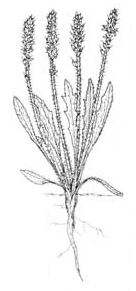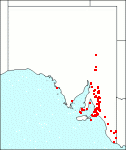Family: Plantaginaceae
Plantago varia
Citation:
R. Br., Prod. Fl. Nov. Holl. 425 ( 1810).
Synonymy: Plantago aff. debilis R.Br. Common name: Variable plantain.
Description:
Perennial herbs with leaves in a basal rosette with a stout tap root, the leaf base with a dense tuft of brown hairs; leaves rarely with an indistinct petiole up to 5 cm long and with a long cuneate base, linear-oblanceolate to linear-elliptic, 6-25 x 0.5-2, acute to obtuse, entire or with widely spaced teeth or lobes, usually with 3 main veins, pubescent, with long and short hairs on both surfaces.
Spikes cylindrical, 1.5-14 cm long, compact or sometimes some fruits widely spaced at the base; peduncle 5-26 cm long, terete, with antrorse hairs more or less appressed, with flowers borne above the leaf apices; bracts ovate, as long as or shorter than the sepals; sepals oblong, usually 2.8-3.5 mm long, subequal, hairy along the central ridge and usually with marginal cilia on a broad membranous margin; corolla tube c. 2.5 mm long; lobes ovate, 2.5-3.5 mm long; anthers oblong, 1.8-2 mm long; ovary 2- or 3-celled, with 2 ovules in the 2 lower cells and 1 above.
Capsule ellipsoid to subglobose, 2.8-3.5 mm long; seeds 1-5, compressed-ellipsoid, c. 1.5 mm long, granular.

| Habit.
|
Image source: fig. 615F in Jessop J.P. & Toelken H.R. (Ed.) 1986. Flora of South Australia (4th edn).
|
|
|
Distribution:
|
S.Aust.: FR, EP, NL, MU, YP, SL, SE. N.S.W.; Vic.; Tas.
|
Conservation status:
native
Flowering time: Aug. — Nov.
|

SA Distribution Map based
on current data relating to
specimens held in the
State Herbarium of South Australia
|
Biology:
No text
Taxonomic notes:
It has a similar dense pubescence on both leaf surfaces as in P. hispida and P. debilis and is distinguished from those by its usually linear-elliptic leaves which tend to become dark when dried (see P. gaudichaudii) and the longer sepals and anthers. Black (1926) and (1957) followed Bentham (1870), Flora Australia, vol. 5, in amalgamating P. gaudichaudii, P. hispida and P. debilis as well as other species with hairy leaves in P. varia.
Author:
Not yet available
|

